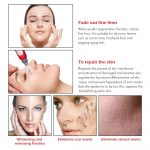Last Updated on 3 years by Francis
Contents
Everything You Need to Know About Infrared Therapy

IR therapy has become more prevalent in recent years, mainly because of new researches that are leading to new advances in IR treatment.
IR
If you are facing problems such as skin sagging, wrinkles, acne, and inflammation, you should try this. This
What is infrared therapy ?
Infrared
In the early 1990s, scientists used IRs to grow plants in space. Scientists have discovered that the intense
Infrared was then studied for its potential application in medicine, including whether IR could increase the energy inside human cells [1]. The researchers hoped that this could be an effective way to treat muscle atrophy, slow wound healing, and bone density problems caused by weightlessness during space travel.
When IR is used with photosensitizing drugs [2], it is called photodynamic
There are many types of
Although there is quite a bit of evidence that RI can be a promising treatment for some conditions, there is still much to learn about how it works.
Infrared therapy VS laser therapy
Infrared skin
Therefore, IR will not cause skin inflammation or erythema after treatment.
But.
Just because
And the best news?
It’s safe enough to do it at home, alone, when you want, and it saves you dozens of visits to the dermatologist and a ton of money.
How does infrared therapy work?
Infrared is thought to act by producing a biochemical effect in cells that strengthen mitochondria. Mitochondria are the engine of the cell – this is where the cell’s energy is created. The energy-carrying molecule found in the cells of all living things is called ATP (adenosine triphosphate).
By increasing mitochondrial function by RLT, a cell can produce more ATP. With more energy, cells can function more efficiently, rejuvenate, and repair the damage.
IRs differ from laser or intense pulsed
The light emitted by the RLT penetrates about 5 millimeters below the surface of the skin.
How Red-Light therapy improves skin health and appearance
Infrared therapy is a natural skin care treatment that has been proven safe and effective in a wide range of clinical research. If you are not familiar with
The short version is as follows:
These red and near-infrared wavelengths stimulate mitochondria in your cells [4] like natural sunlight, reducing oxidative stress and increasing circulation, so your body can produce more central energy to feed itself.
Making energy more productive throughout the body improves physical function, accelerates the healing process, and reduces inflammation and pain, as many peer-reviewed studies have shown. It also significantly improves the health and appearance of the skin, which is why some of the world’s leading beauticians, skin care professionals, and natural health leaders trust it.
Studies have also shown an increase in blood circulation following
What are the advantages?
As mentioned above, some questions remain about the exact functioning of
1. It heals scars and wounds [5].
If you still have acne scars in your teenager, if you have recently suffered burns or if your wounds tend to heal slowly for some reason, then
“I think it’s a great thing from a mitochondrial function point of view,” says Will Cole, D.C., a member of the mbg collective, IFMCP, who recommends it to his patients.
Research seems to suggest that such skin problems respond better at the lower end of the
2. It promotes collagen production.
In addition to its beautifying benefits,
3. Reduces the side effects of cancer treatment.
NASA research has shown that infrared therapy helps to counter a side effect of chemotherapy called oral mucositis, characterized by extremely painful lesions, redness, dryness, and burning sensations in the mouth and throat. A two-year trial in which cancer patients received red and near-infrared LED treatment showed that 96% of patients experienced less pain as a result of this treatment. This is excellent news, as it could help increase food consumption, reduce the use of analgesics, and boost the morale of cancer patients.
4. It relieves joint, muscle, and tendon pain [6].
Since far and near
5. It accelerates recovery and increases endurance [7].
Infrared therapy also has advantages for male and female athletes. One study found that men who participated in intense exercise and who also received
6. It promotes hair growth.
The most common type of hair loss, androgenetic alopecia, affects 50% of men over 40 years of age and 75% of women over 65 years of age, and there are only two drugs approved to help fight it. But research shows that infrared therapy can be a powerful and drug-free solution.
Research review revealed that infrared therapy is safe and effective in promoting hair growth in both men and women.
It seems to work by stimulating the stem cells of the hair follicle and passing the follicles into the anagen phase (the active growth phase). Further research is needed to determine the optimal wavelength to promote hair growth, but one study found that women who received
7. Infrared is a natural anti-inflammatory treatment for the skin.
Infrared
8. Infrared therapy to rejuvenate the skin and reduce fine lines and wrinkles
An in-depth meta-analysis of the effects of
9. Infrared reduces wrinkles and signs of aging:
The analysis cited numerous studies showing how
10. Infrared rejuvenates the skin [9]:
Researchers have noted that
11. Infrared therapy for eczema and psoriasis:
We are just beginning to understand the positive effects that
12. Recover from plastic surgery with infrared
Infrared
Many of these procedures create a lot of inflammation that makes the healing process longer and more painful. The natural anti-inflammatory effects of
In 2015, researchers conducted a systematic review of 40 studies (28 animal and 12 human trials) on healing after plastic surgery and found that
Conclusion: Infrared therapy improves the appearance and healing of the skin.
Infrared
Over the years,
IR therapy for pigmentation
Can IR help with hyperpigmentation?
Although not proven [9] Few professionals suggest that IR can prevent hyperpigmentation following exposure to the sun. Timely
Considering hyperpigmentation, IR exhibits a “normalizing” effect. Since IR penetrates deeper into the cells and helps in the production of collagen, it may help in normalizing the skin coloration.
What about hypopigmentation?
IR may also help to treat pigmentation disorders such as vitiligo and albinism.
It increases the production of melanocyte cells [10] (the cells that form melanin) and reduces any autoimmunity that contributes to depigmentation.
Citations:
[1] https://www.ncbi.nlm.nih.gov/pmc/articles/PMC5505738/
[2] https://www.ncbi.nlm.nih.gov/pubmed/29864428
[3] https://www.ncbi.nlm.nih.gov/pmc/articles/PMC5756569/
[4] https://www.ncbi.nlm.nih.gov/pmc/articles/PMC4387504/
[5] https://www.ncbi.nlm.nih.gov/pmc/articles/PMC3047939/
[6] https://www.ncbi.nlm.nih.gov/pubmed/1727843
[7] https://www.ncbi.nlm.nih.gov/pmc/articles/PMC5733097/
[8] https://www.ncbi.nlm.nih.gov/pmc/articles/PMC3926176/









.jpg)


